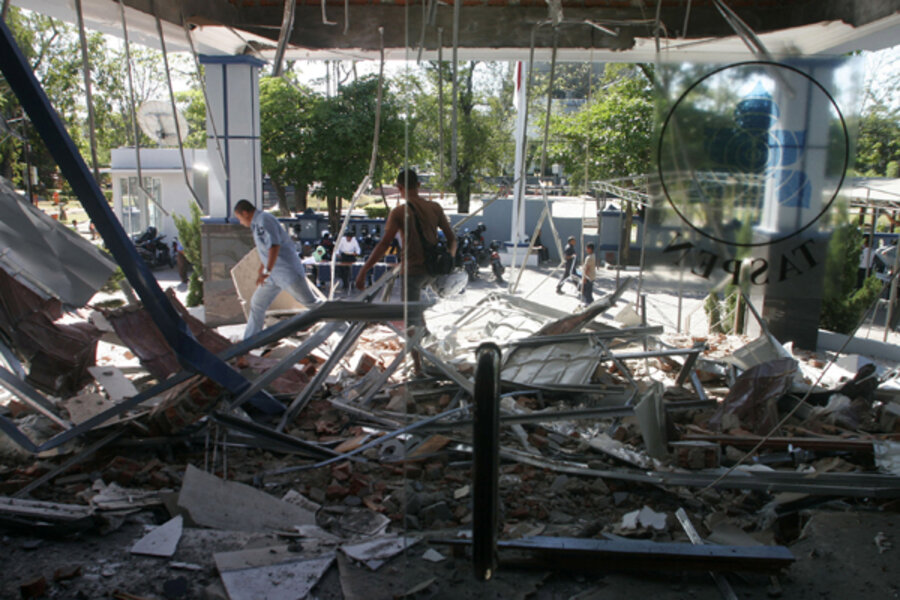Tsunami warning: This time, the system mostly worked
Loading...
| Banda Aceh, Indonesia
It was not like December 2004. Sirens wailed, warnings blared, and police moved millions of people away from coastlines around the Indian Ocean as Wednesday's 8.6 magnitude earthquake off northern Indonesia sparked fears of another devastating tsunami.
Damage was light - the quakes were horizontal rather than vertical - and the big waves never came, unlike eight years ago when walls of water roared across the same ocean and ploughed into seaside communities in 13 countries without warning.
"The reports were of people panicking but there was little damage. We need to check for sure," Eko Budiman, deputy head of the emergency mitigation agency, said at Medan airport in Sumatra, struggling to reach Simeulu island near the epicentre.
Five people died in northern Indonesia, at least two from heart attacks, the agency said.
The alerts and evacuations mean a regional system passed a major test since the tsunami of 2004 that killed 230,000 people, including 170,000 in northern Indonesia alone.
But luck helped avert disaster this time as much as the warning system, especially in Indonesia's Aceh province, where roads were jammed with residents trying to flee and damaged power lines silenced the sirens.
"The simple message is that in any critical condition like this it's impossible to get everyone out in time," said Keith Loveard, chief risk analyst at Jakarta-based security firm Concord Consulting.
"The tsunami alert system worked to a degree.... While awareness has improved, reinforced by 2004, it still needs to get better through public education and government campaigns."
The scenes in Banda Aceh showed the roads are just not big enough, he said, pointing to the need to build up infrastructure and "put cities in a different place."
The 2004 disaster swept in with sudden ferocity. Thailand's southwestern beaches and hotels were packed with tourists on their Christmas vacations and people were out for a stroll on Chennai's Marina Beach in southern India when the waves hit.
System activated in 2006
Made up of seismographic stations and deep-ocean sensors, the Indian Ocean Tsunami Warning System was activated in June 2006 after an agreement at a United Nations conference in Japan.
When a quake hits, data is sent to the Pacific Tsunami Warning Centre in Hawaii and the Japan Meteorological Agency, which coordinate with national tsunami centres in the region.
It can take 15 to 20 minutes for quake data to be analysed and a tsunami watch to be issued to governments and the public around the Indian Ocean. Using their own data, nations warn citizens in a variety of ways - from radio, television, and text messages to sirens and mosque loudspeakers.
In Sri Lanka, officials pressed a "tsunami evacuation" button from an emergency control room in Colombo that alerted 75 warning towers across the island. Within 20 minutes, three million people had moved from the seashore to safer places.
Thailand now has a national disaster warning center in Bangkok that coordinates with its six Andaman coast provinces. The system includes clearly marked evacuation routes, sirens and buoys out at sea that monitor tides.
"The hotel was very good, the staff were very good," said one man staying on Karon beach in Phuket. "They got us moving very quickly, so we feel very safe."
Police with megaphones
In India, authorities asked people to move away from the coast. Police in Chennai cleared Marina Beach and closed the coastal road.
On the Andaman and Nicobar Islands, officials were holding their quarterly disaster preparedness meeting half an hour before the earthquake struck. Most coastal villages on the islands were moved to higher ground after 2004 but police with megaphones evacuated some 2,000 people on Wednesday.
In Aceh, where several buildings suffered damage, including a prison, Armia, a disaster agency official, said the tsunami siren did not sound until 30 minutes after the quake.
"We understand that the ideal is to warn people of a tsunami five to 10 minutes after a quake. I wished we could have," he said. "The power was cut completely and the operators were too scared to turn on the backup power because we saw wires dangling in the street. We decided to turn on the siren in the end."
He said battery-powered sirens may be the answer.
* Writing by John O'Callaghan in Singapore and Frank Jack Daniel in New Delhi; Reporting by Reuters bureaux across Asia; Editing by Nick Macfie and Sanjeev Miglani.







